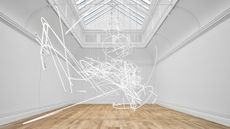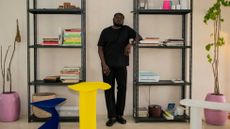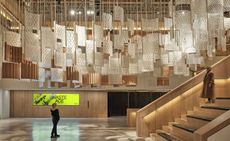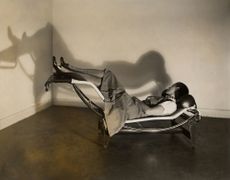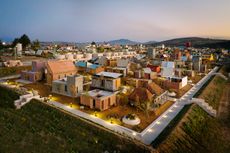Discovered champions new talent at Design Museum
Twenty next-generation designers unveil works in sustainable wood as part of Discovered, a collaboration between AHEC and Wallpaper*, presented at the Design Museum, London
- (opens in new tab)
- (opens in new tab)
- (opens in new tab)
- Sign up to our newsletter Newsletter
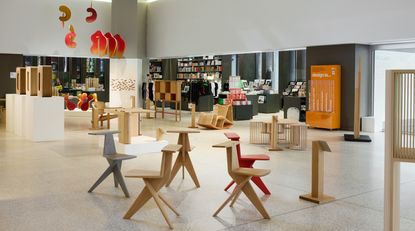
Wallpaper* and the American Hardwood Export Council (AHEC) reveal the results of Discovered, the collaborative platform to promote and support design’s next generation. On show at the Design Museum (13 September – 10 October 2021), the exhibition presents the work of twenty young designers from 16 countries who were tasked with creating new objects in wood, inspired by their pandemic experience to represent the functional and emotional connections to our everyday items.
‘To be able to create an opportunity that gives a platform to a new generation of designers, to express their ideas and communicate their approach to today’s challenges and, at the same time, introduce them to important sustainable materials and connect them to some of the most skilled making workshops, feels absolutely the right thing to be doing,’ says AHEC’s European director David Venables, who led the project alongside Wallpaper* editor-in-chief Sarah Douglas and a quartet of international mentors – Tomoko Azumi, Maria Jeglinska-Adamczewska, Adam Markowitz and Nathan Yong.
‘Emerging designers from across the globe have experienced personal and professional challenges during the pandemic, and the 20 young practitioners have produced a collective display that is inspiring and which shows the resilience and ingenuity of creative design,’ comments Tim Marlow, chief executive and director of the Design Museum.

Seen outside the Design Museum, Kumsuka (Evolve Your Space), a modular, layered seat crafted in thermally modified red oak and imagined for public spaces, by Siyanda Mazibuko
Over the course of several months, each designer developed a piece in collaboration with specialist workshops, working with a specially selected palette of woods. American red oak, cherry, hard and soft maple were chosen for their tactile and visual appeal, and to address the sustainable opportunity of designing with underused and widely available timber that grows abundantly in the American hardwood forests, and has incredible design and performance potential.
‘The environmental case for using more American hardwood in design is totally compelling; low impact, carbon storing, sustainable for the long term and, most importantly, they can provide the performance demanded by good design, as the Discovered collection truly demonstrates,’ says Venables.

Exhibition view of Discovered at the Design Museum
The designers’ approaches to the project varied, highlighting different pandemic experiences and exploring how lockdowns and isolation impacted on local cultural practices.
‘Although there was a brief, it was a reflection on lockdown, and on the pandemic world and how we move out of that,’ comments British designer Mac Collins (winner of LDF’s Emerging Design Medal), whose ‘Concur’ chair celebrated ‘romanticised connotations of contentment, serenity, contemplation and a sense of withdrawal from the rigmarole of socially prescribed routine’.

Exhibition view of Discovered at the Design Museum
For Adelaide-based Ivana Taylor, the pandemic was a moment of ‘really precious quiet time, and mental spaciousness’ during which her practice developed towards a more sculptural approach. This is evidenced in her ‘Reframe’ series of ‘contemplative sculptural objects that triggered reflection on the multi-layered nature of any experience, including isolation’.
Designers involved their families in the design process as they were working from their homes, and were inspired by mundane experiences and everyday life, the desire to connect with nature and the outdoors, and their personal responses spanned both a desire for public connection and an affinity for isolation.
‘This is a time when the next generation needs support more than ever,’ says Sarah Douglas. ‘We are honoured to partner with AHEC and the Design Museum in presenting Discovered, to ensure the designers of tomorrow have the platform they deserve.’
Explore the Discovered projects

Sizar Alexis, Lahmu
Eskilstuna, Sweden
Woods: cherry and scorched red oak
Having lived through the Iraq war in the 1980s, Alexis imagined his home as a bunker, protecting his family and newborn son during the pandemic. Drawing from the similarities between his own childhood experience and his young son’s, his sculptural pieces are defined by stark monolithic forms and stillness, representing the emotional connection to his thoughts in the pandemic. The chunky volumes serve as side tables or stools, and together as a bench or low sideboard, inspired by bunker architecture. Alexis chose two contrasting woods: one half of his piece is in American cherry, for its warmth, and one half is in red oak, its surface burned with a scorching technique.
@sizaralexis

Isabelle Baudraz, Presences
Lausanne, Switzerland / Athens, Greece
Wood: cherry
Fighting a feeling of isolation, Baudraz recreated tactile and emotional connections through her four objects. Inspired by the idea of bringing natural movements and forms into the home, her collection comprises two suspended mobiles, a desk object, and a wall-mounted installation designed to create moments of tactile connection during isolation. Her pieces are made of American cherry: ‘It was an instinctive choice,’ she says. ‘We received all these beautiful samples from AHEC and I was touched by the colour of the cherry and the texture of its grain. I also liked the fact that it was going to evolve and get darker with age.’
@isabellebaudraz

Nong Chotipatoomwan, Thought Bubble
Bangkok, Thailand
Wood: red oak
A nostalgia for travel and social interaction guided Chotipatoomwan’s creative thinking through her project. Physical transitions were replaced with changing states of mind, and the physical realm merged with the psychological realm through domestic space. The designer looked at furniture created for relaxation, and landed on a rocking motion, which became the basis for her chair, offering a mix of relaxation and repetitive movement to enhance mindfulness. She used red oak for the chair, because she was fascinated by its grain. ‘It’s quite expressive and I was interested in its porous nature.’
@nong_kornpetch

Mac Collins, Concur
Newcastle, UK
Wood: cherry
While the term ‘isolation’ has acquired negative meaning over the past 18 months, Collins takes a more positive view. ‘For me, the word has always carried romanticised connotations of contentment, serenity, contemplation and a sense of withdrawal from the rigmarole of socially prescribed routine,’ he says. During his time alone, books became precious companions, and this inspired him to create a place for reflection and reading. His lounge chair and bookrest, a ‘companion object’, encourage the sitter to tune out of daily life and focus on an analogue task. Collins chose cherry for his chair, aiming to create a welcoming, warm and inviting piece.
@maccollins__

Pascal Hien, Migo 01
Berlin, Germany
Wood: red oak
‘The pandemic was a time for pause and reflection, when we became more present with ourselves and our surroundings,’ observes Hien. His object, a multifunctional stool, is the result of his reflections during a time of change and uncertainty, as he learned to adapt and tune out of his fast-paced life. The stool represents a period of constant change: ‘You can adapt it in various ways, there is no front or back, no right or wrong.’ It’s a helper around the house or a place to sit. He chose red oak for its strength and worked on a design with a rational construction: each chair is made from a single plank of red oak (so you get consistency of grain), and its parts are held together with dovetails. While living with his family during the pandemic, Hien involved them in the testing of the piece, for the first time making them a part of his design work.
@pascal_hien

Kodai Iwamoto, Pari Pari
Tokyo, Japan
Wood: red oak
For his project, Iwamoto researched traditional Japanese techniques, such as uzukuri (giving texture to wood by scrubbing) and chouna (chiselling the surface with an adze), and then started experimenting directly on the wood, peeling its layers to create a new veneer. Working with red oak, he peeled it by cutting the panel’s edge and removing the surface by hand, resulting in a jagged effect where the texture of the grain emerges. These imperfectly textured panels became the starting point for a design exploration that led him to a round table shape, using the subtle material as a base to create the effect of an ancient tree trunk.
@kodaiiwamoto

Josh Krute, Toteemi
Helsinki, Finland
Wood: hard maple
Inspired by totems (toteemi meaning ‘totem’ in Finnish), Krute created a multifunctional storage system. As domestic spaces get taken over by work materials during time at home, Krute imagined a series of stackable boxes to stow work supplies and small objects, while other components serve as a side table, tray or stools. The design features a ‘lip’ that serves as a handle, and each box has a different colour on the inside, providing them with a distinguishable character; Krute chose hard maple because of its light hue and ability to take colour. The modular system explores tactile wooden objects, birdhouses and small structures, which Krute streamlined into a compact, practical design. ‘Toteemi provides solutions for how we delve between living and working in the same environment,’ he says.
@josh_krute

Siyanda Mazibuko, Kumsuka (Evolve Your Space)
Johannesburg, South Africa
Wood: thermally modified red oak
The inspirations for Mazibuko’s piece include isicholo, a hairstyle symbolising tribal identity in several African cultures, and indlamu, a traditional Zulu dance practised in celebratory ceremonies. He paired these visual references with a reflection on themes of engaging human behaviour, and the role of design in people’s lives. ‘Engaging with other people is an intrinsic human trait,’ he says, citing this as the reason for his design, a modular, layered seat imagined for public spaces. He took a practical approach, looking into ergonomics and function to create his bench, composed of interlocking strips of thermally modified red oak – timber that has been baked to a high temperature, making it suitable for the outdoors.
@_kumsuka_

Mew Mungnatee, Corners Lamp
Bangkok, Thailand
Woods: soft maple and cherry
Mungnatee’s emotional response to the objects surrounding her took in the relationship between form, light and shadow, and with this project, she explored this connection through geometry. Her lamp designs, inspired by pagodas, are based on a bulb casting a shadow over surfaces below thanks to an intricate grid composition featuring wooden slats and indented corners. She worked with soft maple, because of the manner in which light bounces off its surface (‘The wood has an opalescent gleam,’ she explains) and American cherry for its ability to take stain.
@budd.designstudio

Trang Nguyen, The Roof Stool
Ho Chi Minh City, Vietnam
Woods: cherry, red oak and hard maple
Nguyen looked at traditional Vietnamese roof tiles for her project, creating a collection of nesting stools that replicate the way the tiles overlap to hide the connecting structures below. Her simple stool design is inspired by traditional temple architecture and Vietnamese dresses, and features pins made of contrasting wood at the joint, which remains hidden when the stools are stacked and is revealed when they are in use. ‘I chose the three different types of wood because of their colour differences,’ explains Nguyen. ‘By randomly using two of the species for the pins and another one for the rest for the stool, users can explore the various timbers when they unstack each piece.’ As people have been spending more time at home, her design is imagined to provide additional seats, while creating a beautiful composition when not in use.
@tra.ng.trang

Alessandra Fumagalli Romario, Studiolo 2.0
Milan, Italy
Wood: cherry
During extensive Zooming, video meetings and Insta-lives, Fumagalli Romario observed people’s curated backgrounds, which got her thinking about ‘the importance of objects as extensions of ourselves: from one side, many boundaries are created, from another, boundaries disappear, private and public are mixed together’. She likened this curated space to the small studioli found in Renaissance paintings, and to cabinets of curiosities. Inspired, she created a visual background, a cabinet to present oneself through objects that may be exhibited or hidden. Adding to its intrigue, she angled the vertical planes that divide the cabinet; together with gradient finishing, this creates the illusion of greater depth. Of her cherry wood choice, she says, ‘I wanted a wood that talked by itself. Also, I love its warm colour. It’s a wood that changes colour quickly if exposed to light. It’s important nowadays to have objects that remind us that they come from nature and change and mutate over time.’
@alessandra.romario

Taiho Shin, Ikare
Seoul, Republic of Korea
Wood: hard maple During his time in isolation, Shin noted that ‘objects help human resilience through unusual situations’, and this thought served as the basis for his project. Guided by the ‘Ikea effect’ (consumers place higher value on products they partially created), he thought of a half-made design that users could partly assemble to foster interaction with their objects. He created one small table, put together thanks to an ingenious but simple-to-use joint system (no glue necessary), and the design multiplies to create a stackable system of shelves, suitable for different spaces. He chose hard maple, as the density of the timber means the joint can be moved in and out without crushing the fibre of the wood.
@taihoshin

Mimi Shodeinde, Howard Desk
London, UK
Wood: hard maple
The pandemic world is all about newness, observes Shodeinde: new dangers, and new ways of interacting, living and working. ‘In designing furniture for this new paradigm,’ she says, ‘we should lean into the familiar and the comforting. We should seek freedom, connection, stability and strength.’ These qualities are to be found in her design: a solid desk whose light forms contrast with the rigorous construction and weight of the wood. The designer looked to a vast pool of cultural references, from the compositions of British sculptor Barbara Hepworth to the modernist architecture of Lina Bo Bardi, and the aerodynamics of flight (pilot Howard Hughes inspired the name of the piece). These influences converged into a sinuous silhouette, a design that challenges the familiar but also offers a sense of safety.
@miminat_designs

Juan Carlos Franco & Juan Santiago Sierra, Riverside Medellin,
Colombia / Barcelona, Spain
Wood: cherry
During isolation, objects change their function and their meaning, and we find ourselves looking for space within our space. This was the observation that kicked off Franco and Sierra’s project, which looks at how our furniture changes purpose and how adaptability is key (in a pandemic as much as in modern living). Inspired by adaptable design (such as the pile dwellings, or stilt houses, in Colombia), they created a bench that suits different needs, thanks to the addition of accessories such as trays, dividers and storage that fuse into a central fissure. This way, the bench becomes a multifunctional space that can adapt to home, workspace or public environment. The designers chose cherry for their piece: ‘We’d never worked with cherry before, and it was a great opportunity to take advantage of that wood,’ says Sierra. ‘Also, we saw what our mentor, Maria Jeglinska-Adamczewska, did with her table and chair in AHEC’s previous project, Connected. It was made from cherry and it was really beautiful: we loved the grain and the texture.’
@juancarlosfg @juan.santiagosierra

Ivana Taylor, Reframe
Adelaide, Australia
Woods: hard maple, cherry and red oak
Taylor’s own experience of solitude led to extensive periods of reflection, ultimately inspiring her to change her approach to designing and making. For this project, she aimed to ‘design a contemplative sculptural object that triggered reflection on the multi-layered nature of any experience, including isolation’. A recurring theme of her research featured ways of framing a view at different scales, and the resulting design is a sculpture made from a series of small carved objects that layer to create a composition acting as a ‘sculpted path for light’. Working with three woods, Taylor was interested in exploring different material hollows, cutting each layer to expose the wood’s grain.
@ivanataylordesign

Martin Thübeck, Rå
Stockholm, Sweden
Wood: red oak
While confined at home with his young children, Thübeck found inspiration in the way they adapted their surroundings for play, challenging conventional ways to use furniture: ‘Limitations became possibilities,’ he comments. After looking at traditional furniture and playground equipment, he developed a piece (Rå, meaning ‘pure’ in Swedish, also referring to a mythical forest creature from local folklore that can change its appearance) whose construction is informed by Swedish craft, and whose function can be interpreted either as a chair or a slide, as it is flipped upside down. He chose red oak for his design, based on the way the wood soaks up pigment and gives depth to it. ‘This piece is a symbol of coexistence, and the act of turning it is like moving between worlds,’ he says, citing an approach that merges the indoor and outdoor, staticity and movement, adults’ and kids’ points of view. ‘My intention is not to fully merge the two functions, but to see what happens when they are so close to each other that they are perceived as one,’ he says.
@mratin

Yunhan Wang, Winding Stream
Zhuhai, China
Wood: hard maple
Unable to carry out certain customs during lockdown, people are confined to performing rituals at home. There is a novel need for suitable furniture and objects that can fit a small space but serve the same purpose. Wang wanted to create a domestic alternative to the ‘winding stream party’, a Chinese drinking custom in which poetry is composed while a cup is floated down a stream with people sat on both sides; the person sitting in front of the cup that stops has to drink it. Inspired by Hakka round houses, Wang created a compact table design with storage concealed in the legs and a central slit to fit trays and cups. The table is also equipped with a drain so users can dispose of their water through the twisting gully, and it then trickles into a waste bucket housed in the main leg. Wang chose hard maple for Winding Stream because she was drawn to the light colour, and the timber has been spray-painted to prevent rot from setting in.
@dorisofia21

Vivienne Wong, Iuxta Me (beside me)
Melbourne, Australia
Wood: cherry
Dancer-turned-designer Wong looked at non-verbal communication as the starting point of her project, approaching the task from a personal point of reflection and knowledge. ‘I wanted to translate my previous understanding of how we can connect and communicate,’ she says, and looked to create a piece to nurture strength, intimacy and connection. Invisible physical boundaries and the creation of textures through light formed the basis of the project, which developed into a coffee table featuring interlocking echoed forms, where the functional joinery also became a decorative motif for the piece. Wong chose American cherry because of its grain and colour. ‘It has a beautiful warmth in its pinkish, red hue,’ she says. ‘I felt that supported everything I was trying to put into this piece.’ Her design’s name (using the Latin word for ‘beside’) represents the desire for human connection and closeness that guided the process.
@vivienne_l_wong

Tan Wei Xiang, Recollect
Singapore
Woods: hard maple and red oak
Searching for a tangible physical connection to loved ones (beyond virtual calls), Tan turned to keepsakes as a way to fight nostalgia. His keepsakes cabinet is imagined as a way to hold, preserve and give respect to the items we hold dear. Its forms were inspired by Singapore’s ubiquitous construction sites and the ridged zinc sheets used to protect them. Tan recreated this motif as the outer shell of his tall, lean cabinet, and created curved shelves to sit inside it, with a mirrored, polished brass circle, mimicking the sun setting on the horizon. The designer had worked with maple before but never from the American hardwood forests and, for this project, he selected a combination of hard maple of different thicknesses to achieve the ‘crinkled’ effect on the shell, and red oak for the curved shelves inside.
@helloweixiang

Duncan Young, Shelter Within
Adelaide, Australia
Wood: hard maple
Young focused on the materiality of timber, and how this organic material can help us connect with nature while confined at home. ‘For those in dense urban environments, lockdowns have impacted our physical and mental strength by limiting the biological need humans have for being in outdoor spaces,’ he says. He looked at studies analysing the positive impact of nature on physical and mental health, and in response created a modern cabinet of curiosities as a pillar to nature, for the user to engage with the natural world while at home. Featuring a solid carcass with discreet joinery and a moiré-effect shelf (a design inspired by the historic symbolism of the cabinet as a theatre), the simple plinth includes two glass sculptural elements handmade at Young’s studio, refracting and distorting the light to evoke the effect of walking beneath a canopy of trees. Young used hard maple to create the carcass. ‘It’s such a pared-back timber,’ he explains. ‘It has a gentle grain structure and I thought the lightness would soften the heaviness of my piece’s form.’
@duncanyoungstudios
INFORMATION
Discovered is on view at the Design Museum from 13 September to 10 October 2021
ADDRESS
224-238 Kensington High St
London W8 6AG
VIEW GOOGLE MAPS (opens in new tab)
Rosa Bertoli was born in Udine, Italy, and now lives in London. Since 2014, she has been the Design Editor of Wallpaper*, where she oversees design content for the print and online editions, as well as special editorial projects. Through her role at Wallpaper*, she has written extensively about all areas of design. Rosa has been speaker and moderator for various design talks and conferences including London Craft Week, Maison & Objet, The Italian Cultural Institute (London), Clippings, Zaha Hadid Design, Kartell and Frieze Art Fair. Rosa has been on judging panels for the Chart Architecture Award, the Dutch Design Awards and the DesignGuild Marks. She has written for numerous English and Italian language publications, and worked as a content and communication consultant for fashion and design brands.
-
 Cerith Wyn Evans: ‘I love nothing more than neon in direct sunlight. It’s heartbreakingly beautiful’
Cerith Wyn Evans: ‘I love nothing more than neon in direct sunlight. It’s heartbreakingly beautiful’Cerith Wyn Evans reflects on his largest show in the UK to date, at Mostyn, Wales – a multisensory, neon-charged fantasia of mind, body and language
By Harriet Lloyd-Smith • Published
-
 Nifemi Marcus-Bello is the Nigerian designer shaping Africa’s designscape
Nifemi Marcus-Bello is the Nigerian designer shaping Africa’s designscapeAmong Wallpaper’s ‘Future Icons’, Lagos-based designer Nifemi Marcus-Bello speaks of creating a local manufacturing network and documenting design production in Africa
By Ugonna-Ora Owoh • Published
-
 Luxury loungewear brands to hibernate in this winter
Luxury loungewear brands to hibernate in this winterAs days get shorter and temperatures drop, we present the best loungewear for luxuriating in this autumn and winter, from brands including Loro Piana, Raey, Extreme Cashmere and more
By Tilly Macalister-Smith • Published
-
 Design Museum exhibition puts waste front and centre
Design Museum exhibition puts waste front and centre‘Waste Age: What Can Design Do?’ at the Design Museum, London (until 20 February 2022), presents design’s proposals and solutions to the issue of waste
By Rosa Bertoli • Last updated
-
 Charlotte Perriand’s life and work explored at London’s Design Museum
Charlotte Perriand’s life and work explored at London’s Design MuseumLondon’s Design Museum presents ‘Charlotte Perriand: The Modern Life’, an exhibition turned the spotlight on one of the most iconic creators of the 20th century
By Rosa Bertoli • Last updated
-
 Design Museum announces Beazley Designs of the Year winners
Design Museum announces Beazley Designs of the Year winnersSeesaw installation Teeter-Totter Wall, by Ronald Rael and Virginia San Fratello with Colectivo Chopeke won the design accolade, s elected by a jury chaired by journalist Razia Iqbal and including fashion designer Samuel Ross and material innovator Seetal Solanki. The winners of the annual awards demonstrate how design can suitably respond to issues of social justice, climate change and the pandemic
By Rosa Bertoli • Last updated
-
 Beazley Designs of the Year is a blueprint for our turbulent year
Beazley Designs of the Year is a blueprint for our turbulent yearCurated by Emily King, the Beazley Designs of the Year exhibition captures how design has responded to social justice, climate change and Coronavirus
By Sujata Burman • Last updated
-
 Meet the Design Museum’s all-female Designers in Residence
Meet the Design Museum’s all-female Designers in ResidenceThe multidisciplinary cohort includes Enni-Kukka Tuomala, Abiola Onabule, Cynthia Voza Lusilu and Ioana Man, who developed a series of multidisciplinary projects with the Design Museum, responding to the theme of ‘Care'
By Rosa Bertoli • Last updated
-
 Design Museum's tribute to club culture reopens post lockdown
Design Museum's tribute to club culture reopens post lockdownArt, photography, typography, shape shifting installations and music come together at Design Museum’s ‘Electronic: From Kraftwerk to The Chemical Brothers’
By Simon Mills • Last updated
-
 Beazley Designs of the Year 2019 winners announced
Beazley Designs of the Year 2019 winners announcedAt the Design Museum ceremony in London tonight, Muji, Pentagram and Adidas are among the winners of the coveted Beazley Designs of the Year 2019
By Sujata Burman • Last updated
-
 Design Museum London invites you to move to Mars
Design Museum London invites you to move to MarsMoving to Mars opens at Design Museum London, aiming to answer some of the big questions around moving to a different planet
By Harriet Thorpe • Last updated
